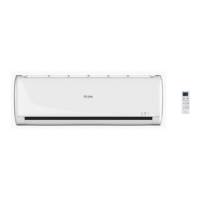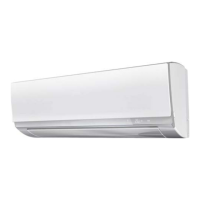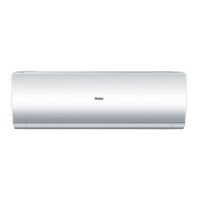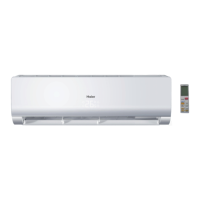Do you have a question about the Haier AS12TB3HAA and is the answer not in the manual?
Explains the alphanumeric code used for model identification.
Lists critical warnings and precautions for performing repair work safely.
Provides essential guidelines for ensuring product safety and integrity post-repair.
Details post-repair checks to confirm proper functioning and safety.
Explains the meaning of icons used to highlight important information in the manual.
Lists key features like fan settings, timers, and operational modes.
Details voltage, phase, and frequency requirements for the system.
Outlines rated capacity, power consumption, and energy efficiency ratings.
Provides detailed technical data including dimensions, weight, and sound levels.
Lists specifications for individual components like fan, heat exchanger, and filters.
Provides formulas for converting between different units of measurement.
Describes the type and function of the indoor and pipe sensors.
Illustrates the refrigerant flow and components during cooling operation.
Illustrates the refrigerant flow and components during heating operation.
Shows the electrical connections and component layout for the indoor unit PCB.
Details the connections for various connectors on the indoor PCB.
Overviews the primary functions and control logic of the air conditioner.
Explains how the unit automatically selects operating modes based on room temperature.
Details temperature control ranges, precision, and compressor behavior in cooling and heating.
Describes the control logic and temperature settings for dehumidifying operation.
Details heating mode operation, cold draft prevention, and temperature protections.
Explains the conditions and procedures for the automatic defrosting cycle.
Details how to set and use the 24-hour timer function for on/off operations.
Describes how the sleep mode adjusts temperature and fan speed for comfort.
Explains the function of the emergency switch for operation modes.
Details the steps and expected behavior during a test run of the unit.
Explains the power-down memory and auto-recovery features of the unit.
Describes the conditions and signals for an indoor fan motor malfunction alarm.
Provides a table of resistance values for the indoor unit's room sensor at various temperatures.
Provides a table of resistance values for the pipe sensor at various temperatures.
Shows the external dimensions of the indoor unit with measurement indicators.
Illustrates the center of gravity for the indoor unit.
Provides warnings and guidelines before performing diagnostic procedures.
Lists specifications for key electronic components like the fan motor.
Outlines common operational problems and the corresponding checks and measures to resolve them.
Lists error codes displayed on the unit and their corresponding descriptions and reference pages.
Details troubleshooting steps for thermistor and related sensor malfunctions, including error codes E1 and E2.
Guides troubleshooting for EEPROM errors (E4), focusing on data, EEPROM chip, and PCB issues.
Provides troubleshooting for fan motor malfunctions (E14), including checks for wiring, motor, and PCB.
Presents the detailed electronic circuit diagram for the indoor unit, showing component interconnections.
Identifies the specific type and series of the air conditioner for which the procedure applies.
Details the steps for safely removing the front panel of the indoor unit.
Explains the simple process of lifting and pulling out the air filters.
Details loosening screws, releasing hooks, and removing the casing.
Guides the removal of the horizontal flap and the stepper motor.
Describes how to remove the horizontal louvers and the main control box.
Outlines the steps to loosen hooks, screws, and lift out the heat exchanger.
Details the process of loosening screws and removing the fan motor cover.
Explains how to loosen screws, lift the motor, and remove the fan rotor.
Explains the alphanumeric code used for model identification.
Lists critical warnings and precautions for performing repair work safely.
Provides essential guidelines for ensuring product safety and integrity post-repair.
Details post-repair checks to confirm proper functioning and safety.
Explains the meaning of icons used to highlight important information in the manual.
Lists key features like fan settings, timers, and operational modes.
Details voltage, phase, and frequency requirements for the system.
Outlines rated capacity, power consumption, and energy efficiency ratings.
Provides detailed technical data including dimensions, weight, and sound levels.
Lists specifications for individual components like fan, heat exchanger, and filters.
Provides formulas for converting between different units of measurement.
Describes the type and function of the indoor and pipe sensors.
Illustrates the refrigerant flow and components during cooling operation.
Illustrates the refrigerant flow and components during heating operation.
Shows the electrical connections and component layout for the indoor unit PCB.
Details the connections for various connectors on the indoor PCB.
Overviews the primary functions and control logic of the air conditioner.
Explains how the unit automatically selects operating modes based on room temperature.
Details temperature control ranges, precision, and compressor behavior in cooling and heating.
Describes the control logic and temperature settings for dehumidifying operation.
Details heating mode operation, cold draft prevention, and temperature protections.
Explains the conditions and procedures for the automatic defrosting cycle.
Details how to set and use the 24-hour timer function for on/off operations.
Describes how the sleep mode adjusts temperature and fan speed for comfort.
Explains the function of the emergency switch for operation modes.
Details the steps and expected behavior during a test run of the unit.
Explains the power-down memory and auto-recovery features of the unit.
Describes the conditions and signals for an indoor fan motor malfunction alarm.
Provides a table of resistance values for the indoor unit's room sensor at various temperatures.
Provides a table of resistance values for the pipe sensor at various temperatures.
Shows the external dimensions of the indoor unit with measurement indicators.
Illustrates the center of gravity for the indoor unit.
Provides warnings and guidelines before performing diagnostic procedures.
Lists specifications for key electronic components like the fan motor.
Outlines common operational problems and the corresponding checks and measures to resolve them.
Lists error codes displayed on the unit and their corresponding descriptions and reference pages.
Details troubleshooting steps for thermistor and related sensor malfunctions, including error codes E1 and E2.
Guides troubleshooting for EEPROM errors (E4), focusing on data, EEPROM chip, and PCB issues.
Provides troubleshooting for fan motor malfunctions (E14), including checks for wiring, motor, and PCB.
Presents the detailed electronic circuit diagram for the indoor unit, showing component interconnections.
Identifies the specific type and series of the air conditioner for which the procedure applies.
Details the steps for safely removing the front panel of the indoor unit.
Explains the simple process of lifting and pulling out the air filters.
Details loosening screws, releasing hooks, and removing the casing.
Guides the removal of the horizontal flap and the stepper motor.
Describes how to remove the horizontal louvers and the main control box.
Outlines the steps to loosen hooks, screws, and lift out the heat exchanger.
Details the process of loosening screws and removing the fan motor cover.
Explains how to loosen screws, lift the motor, and remove the fan rotor.
| Cooling Capacity (Ton) | 1 Ton |
|---|---|
| Energy Efficiency Rating | 3 Star |
| Compressor Type | Rotary |
| Type | Split |
| Cooling Capacity | 12000 BTU/h |
| Air Flow | 550 CFM |
| Noise Level | 42 dB |
| Power Supply | 230V / 50Hz |
| Air Flow Volume | 550 CFM |
| Noise Level (Indoor) | 42 dB |












